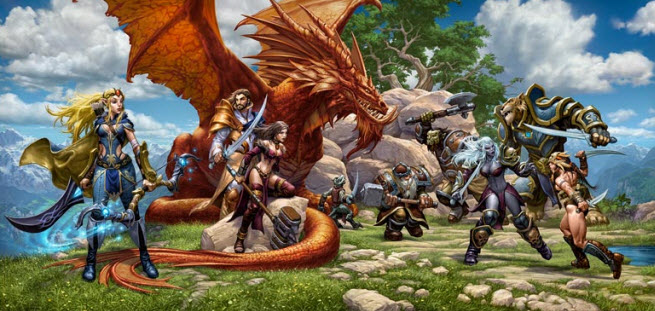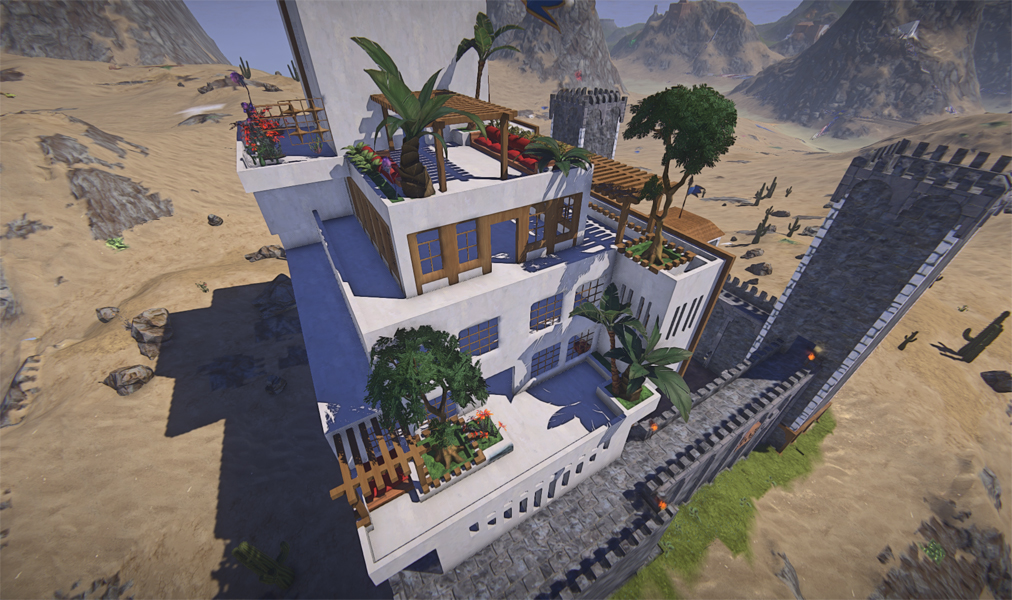SAN FRANCISCO — Sony Online Entertainment was one of the first developers to learn that massively multiplayer online games need to be continuously evolving in order to keep potentially millions of players engaged over the course of many years. In today’s market, players need to have a hand in guiding that evolution, and that’s the mantra guiding the development of Planetside 2 and EverQuest Next Landmark.
We could view this as SOE coming full-circle on something it pioneered in 2003 with the release of Star Wars: Galaxies, in which players could craft almost every item in the game. We could also look at it as SOE taking a nod from Eve Online, which figuratively provides a sandbox and steps back to enable players to do whatever they want with it. Eve Online has been so successful that it continues to run off a subscription model even though that the MMO worlds considers that monetization scheme is dying — or already dead.
Planetside 2 and EverQuest Next Landmark are free-to-play games, and SOE has demonstrated with Planetside 2 that it understands the right way to deploy the F2P model. You give the player a deep experience and then count on engagement and loyalty to motivate players to spend money. The Planetside 2 Roadmap transparently lists upcoming changes to the game and solicits player feedback, and we spoke about some of those upcoming additions in more detail with Tramell Isaac, the senior art director for Planetside 2.
Join up and see the universe
Outfits in Planetside 2 are like independent battalions within armies. They’re roughly comparable to guilds or clans in other MMOs. The chief benefit of a guild or a clan, other than forging in-game relationships, is providing the necessary organization to tackle late- and end-game content. For a combined-arms multicontinent warfare exercise like Planetside 2, the overall state of the war and the ebb-and-flow of territory control is the endgame. From that perspective, outfits are not as optional in Planetside 2 as guilds and clans are in other MMOs.
The endgame in Planetside 2 is also not a matter of static, high-level experiences that players earn the right to engage with by ranking up characters. Players are engaged with Planetside 2’s endgame and hence crafting the game world with the very first shot they take. SOE is trying to make it easier for players to find and join outfits and therefore hook new Planetside 2 players into the game more quickly.
“We’re trying to get a good, clean spot that’s useful and something that’s not intrusive, something that can be seen by everybody but not necessarily like ‘Bam! In your face! Come with us!’” said Tramell.
Players in Planetside 2 fight for control of bases that are roughly the size of a map in Call of Duty, and bases litter each continent, which inspired one idea in development to advertise outfits . “If you’re part of an outfit and you capture a base, your logo gets splattered where the flags are, so everybody knows which outfit actually captured the base,” said Tramell.
SOE is developing a mission system for Planetside 2 that will more easily tie players into the metagame. The first iteration of the system is in beta testing, and it’s driven by procedurally generated missions that reflect battlefield conditions, such as directing players to hotspots on the map to achieve certain objectives.
“Then it’s going to evolve into I as an outfit leader, or I as a platoon leader or a squad leader, being able to say, ‘We need [heavy infantry] in this area,’ and if you’re [heavy infantry], you show up there and you get XP for showing up because you just completed that mission,” said Tramell. “We’ve worked a lot on the [character] classes, and expanding the role of the classes, but one thing we haven’t really touched is that command role.”
Handing players the keys
Expanding players’ ability to control the war represents support for a more abstract form of player content creation. SOE is also supporting more tangible player-driven efforts in Planetside 2 like Community Clash, and the Recursion Real Time Stat Tracker.
Community Clash organizes battles between teams from different player outfits in Planetside 2. Each outfit fields 24 or 48 players and fights with other teams in a tournament-style bracket system. SOE caught wind of this and donated server space to enable the Community Clash players to conduct their tournaments without being bothered by the larger war erupting all around them.
Sony Online Entertainment’s API team assists the player-developers of the Recursion Real Time Stat Tracker, a user interface overlay that enables Planetside 2 players to track their performance info, and which also includes audio information like announcing the player’s headshots and double kills as a kind of motivational tool. SOE gives the Recursion developers access to the Planetside 2 statistical data they need in order to make the overlay a success.
“Our job as developers and for the longevity of the product is to allow people to make this thing expand organically, as opposed to forcing, ‘Here’s the rules, you play within the rules or you don’t play at all,’ like most developers do,” Tramell said.
If you build it they may buy it, or the developers might use it
Planetside 2 is also one of three current Sony Online Entertainment games that supports Player Studio, which enables players to create virtual items and upload them into the SOE Marketplace for purchase. In the case of Planetside 2, players can create armor pieces, camouflage schemes, cockpit designs, and decals. They’re all strictly aesthetic items, and Tramell said that one player creator has made over $12,000 since last September.
Permitting players to build items for use in-game is the essence of the other SOE game we saw at the Game Developers Conference. EverQuest Next Landmark is like a marriage of Minecraft’s creative mode with traditional MMO interfaces, and it’s part of SOE’s understanding that it isn’t good enough to just take new graphics and quests and lay them over the same, basic MMO design over and over again.
EverQuest Next will be a fully destructible world. EverQuest Next Landmark is a fully constructible world, and the two games are meant to interplay with one another. In fact, the tools that players will use to build things in EverQuest Next Landmark are the same tools that SOE’s designers are using to build EverQuest Next.
Landmark began as a way to encourage EverQuest fans to design content for the next MMO in the franchise. Dave Georgeson, the director of development for the EverQuest franchise, told us that the experiment snowballed into an idea for creating persistent worlds, set in the EverQuest universe that players would have complete control over, and that idea evolved into Landmark.
“The players, in the first two weeks of alpha, developed four or five, maybe even six different unique ways of using our tools that we were completely unaware was possible,” said Georgeson. The basic interface enables players to shape objects into new objects, which can then be saved as templates, and to use basic textures, as the basis for architectural construction, which is similar in spirit to Minecraft’s creative mode.
Landmark also borrows from Minecraft’s survival mode in that players aren’t given access to the full panoply of potential building materials right from the beginning of the game. Landmark players will spawn with a stone ax and a stone pick, and they’ll explore the world and sample materials in order to gain access to them in free construction. Players will then be able to combine simple materials into more complex materials and gradually unlock all of their building options.
“At the beginning of the game, one of the other things that you have in your inventory is a claim flag. It’s just like an Oklahoma Sooner rush, where they run out there on day one and everybody’s looking for a cool place to put their flag,” said Georgeson. Players control a cube of space around wherever they place their claim flag, with a buffer zone around that space to prevent other players from boxing them in, and players can eventually build more claim flags as they gather more resources.
“The world is deep, I mean, really deep. It’s like a mile deep, and it’s filled with caverns and things to explore,” said Georgeson. The deeper players go, the more valuable the resources they discover. Sound familiar?
Georgeson showed us one island in the demo, and it was already littered with player claims. “There are 50 islands on a world, and there are many worlds,” Georgeson said. Players can pick up and move their claims near the claims of other like-minded players if they all want to explore a certain architectural style of theme, for instance.
SOE will host contests wherein Landmark players build structures which the Landmark audience then votes on, and when the community has grown adept enough in their construction skills, Georgeson and his team will spin up Landmark worlds where the only restriction is that players work within the art direction of Norrath, the location of the EverQuest games.
“As we build Norrath we’ll be like, ‘Hey, we’re going to do Innothule Swamp this month, and here’s our art guide for what we’re gonna be doing. Anybody who wants to participate with us, these are the kinds of things we’d love to see,’ and then that stuff all gets pulled over and permanently part of Next,” said Georgeson.
VentureBeat's mission is to be a digital town square for technical decision-makers to gain knowledge about transformative enterprise technology and transact. Learn More



